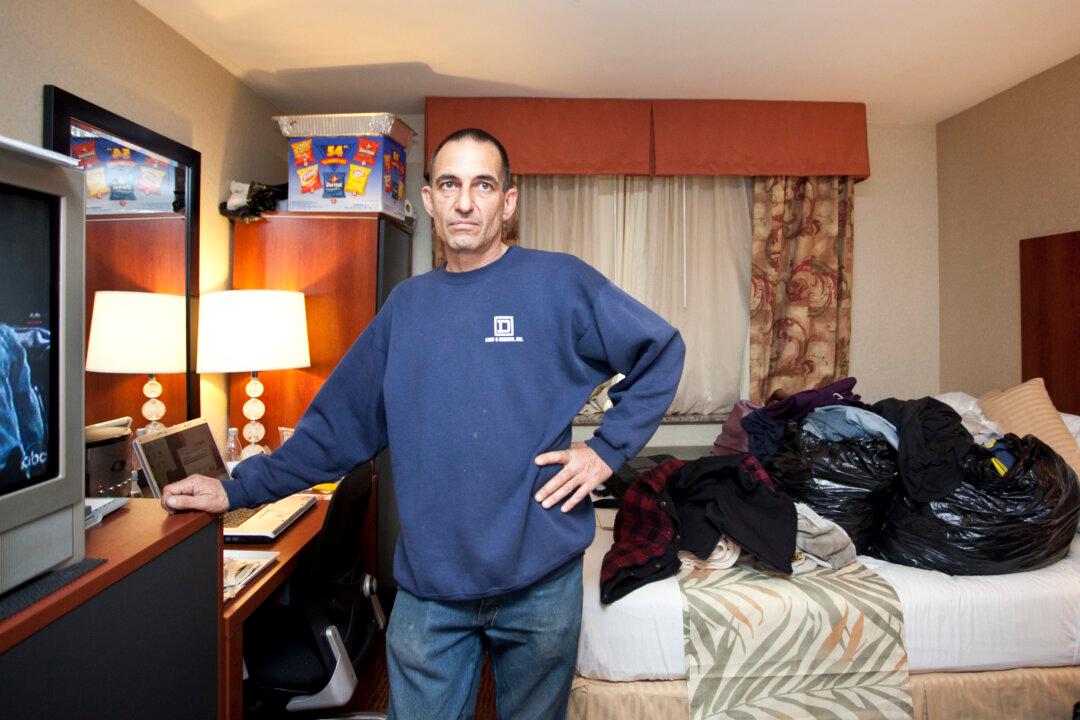STATEN ISLAND, N.Y.—Richard Fabio, 53, has become adept at living in a hotel room. He darts to the bathroom sink to fill his coffee machine with a small water bottle. It takes several trips in tight quarters, made tighter by bags of unwashed clothes that seem to be everywhere.
“I drink a pot of coffee a day,” he says, laughing. “I stopped counting it in cups.”
Fabio is one of hundreds of Hurricane Sandy survivors who have been living in hotel rooms for months.
As of May 3, there are still 435 households in the city- and FEMA-sponsored hotel programs, according to the Department of Homeless Services (DHS). The program was set up for Hurricane Sandy evacuees whose homes were destroyed or rendered unlivable by the storm.
Fabio’s home in Great Kills was among those on Staten Island particularly hard hit.
“A guy like me who lost my business and my house—I couldn’t finance a piece of Bazooka gum [now],” says Fabio, who has been in the hotel program since Dec. 22 and is now living in the Staten Island Ramada Inn.
After 20 years of repossessing cars for a living, his business has dried up and his job prospects are uncertain.
Making matters worse is the imminent eviction that those in the hotel program are facing.
The city hotel program was set to end on April 30, but at the 11th hour, Legal Aid and Weil Gotshal and Manges LLP stepped in with a lawsuit to prevent the city from evicting evacuees. The new deadline is May 15, when a judge will rule on the case.
In a May 8 legal brief responding to the lawsuit, DHS Commissioner Seth Diamond states that Sandy evacuees still in hotels should be evicted as scheduled and go live in homeless shelters if they have no other options.
“It is important to understand that the Hotel Program was never intended to supplant the City’s homeless shelter system as a refuge for homeless New Yorkers until they can transition to homes of their own,” states Diamond in the legal brief.
“We’re confident that, based on our substantial efforts, most evacuees would be linked to housing, and those remaining in the Program as of April 30 who still required an interim place to stay could readily access the City’s shelter system.”
The shift of labeling Sandy evacuees as “homeless New Yorkers” is consistent with the manner in which DHS has been handling many of the evacuees in the hotel program.
For Fabio, he’s unwilling to take the situation sitting down.
During an April 26 City Hall hearing, Fabio and other Sandy evacuees testified about their complicated circumstances. They spoke of insufficient caseworker assistance as cause for why they don’t yet have a permanent place to live. In Fabio’s case, his house has a cracked foundation, and he is in the process of getting an apartment. He took the chance during the hearing to personally confront DHS Commissioner Diamond.
“I want to know what I’m supposed to do,” Fabio asked Diamond as he was exiting the hearing. Diamond’s response: silence.
Fabio isn’t the only Sandy evacuee in the hotel program who has made it his business to advocate for help. Many of the people who showed up at a rally before the hearing are living in the hotels, including families with children.
One of them, Alycia Sapp, lives with her twin 18-year-old daughters, one of whom gave birth to a baby just 5 weeks ago. Sapp is the lead plaintiff in the lawsuit against the city and is currently living in the Clarion Hotel in East Elmhurst.
She says she doesn’t trust the city’s assurances that they will track down evacuees who leave the hotels after more federal funds arrive.
“If I leave, I’d no longer be a Sandy victim, I’d be a homeless person,” says Sapp, who adds that her case manager with third-party provider S.C.O. told her to go to a shelter with her newborn grandson. “She (the case worker) told me, ‘There are a lot of women with babies in the shelters.’”
Other Sandy evacuees who are in hotels are advocating for themselves—and others.
Allison Puglisi, who owns a home in Staten Island, has health problems and can’t live in her home because of mold. Puglisi has been living in a cramped room in the Staten Island Ramada Inn, but finds time to protest the city’s treatment of Sandy victims.
“Why are they telling people to live in moldy houses?” asks Puglisi, who regularly joins Sandy-related community events, even if they aren’t directly related to her. Despite needing a cane to walk, on Tuesday she spent at least two hours with media and activists touring houses being rebuilt or still awaiting repairs because of mold on a tour organized by Make the Road, N.Y.
“I’ve always been a bit of an activist for things that matter,” says Puglisi.




